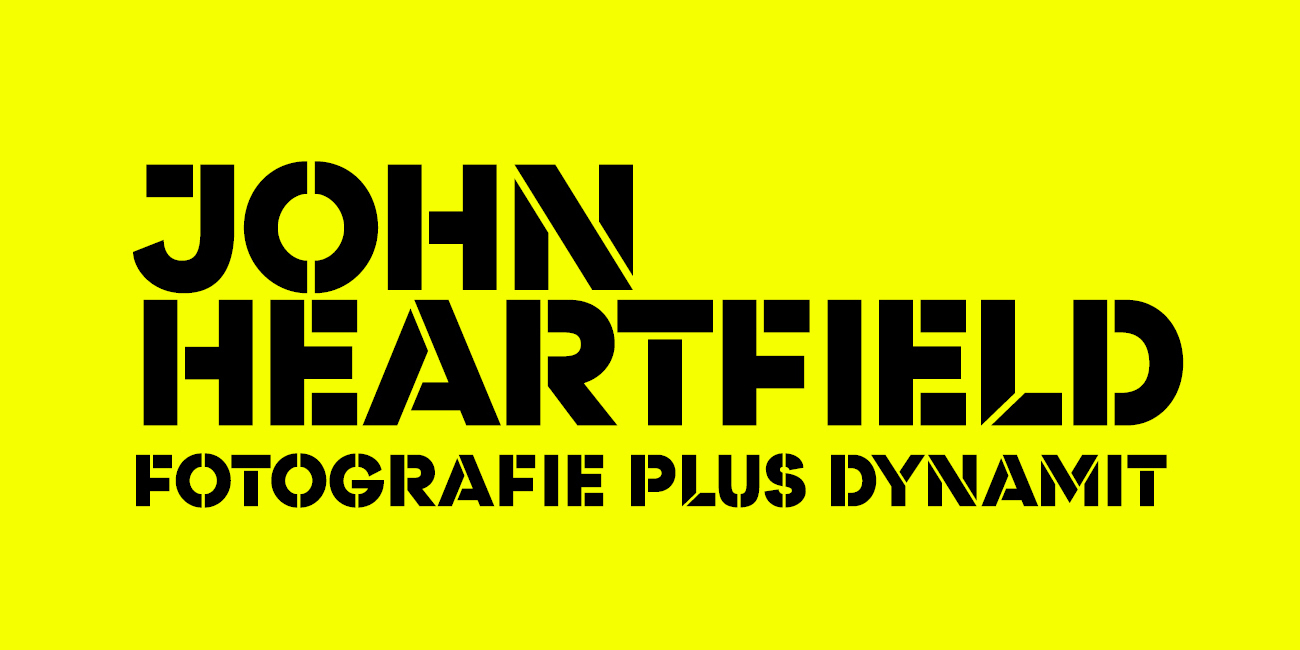The exhibition on the first upper level at the Munich Documentation Center is divided into five sections:
War Against War
Warnings about the horrors of war are a central motif in John Heartfield’s oeuvre. World War I sparked his uncompromising pacifism and fueled his turn to photomontage as a revolutionary art form. His anger was primarily directed at what he considered a lethal alliance between militarism and capitalism. The artist exposed Adolf Hitler and the National Socialists as dangerous warmongers from the start. Heartfield made use of a repertoire of iconographic images and symbols in his allegorical representations of war. It included battlefields showing fallen soldiers as well as bayonets, gun barrels, spiked helmets, medals, and other militaristic insignia.
‟Slicing Through Lies”
John Heartfield used photomontage strategically to undercut National Socialist propaganda. Through his cunning interplay of image and text, he demystified the daily lies spread by the Nazis and revealed the truth. In the last years of the Weimar Republic, the Arbeiter-Illustrierte Zeitung (AIZ), in which numerous works by Heartfield were published, became an important weapon in the Communist election campaign. The newspaper garnered international attention for its biting commentary on current political affairs. John Heartfield’s photomontages always allude to the inherent manipulability of both photographs and facts. Today the political battle surrounding “the truth” rages on; its contemporary manifestations include maxims such as “Lügenpresse” (the lying press) and “fake news.”
United in the Fight
John Heartfield understood his art as a contribution to the political struggle in the interests of the working class. From a profound sense of justice and in opposition to the ruling elites, he joined the Kommunistische Partei Deutschlands (KPD, German Communist Party) on the day it was founded. In the 1920s Heartfield designed election campaign posters, flyers and emblems as well as illustrations and layouts for publications in the KPD’s Agitation and Propaganda Department and the associated paramilitary alliance Roter Frontkämpferbund (Red Front-Fighters). Nevertheless, his aesthetics and incisive motifs also met with resistance. The KPD was skeptical of the use of images and art in propaganda, and of the avantgarde. From today’s view and with hard-earned hindsight brought about by the experiences of the 20th century’s dictatorial regimes, Heartfield’s symbolic repertoire of muscular men, fists and flags appears problematic. At the same time, his critique of militant nationalism and capitalist exploitation remains highly relevant. Recently, the Black Lives Matter movement, for example, has reactivated the symbol of the raised fist.
A Life of Ruptures and Adaptation
The 20th century’s political upheaval left behind both biographical and ideological ruptures in John Heartfield’s life and work. He was repeatedly forced to adapt to changing working conditions and new political frameworks. While in exile in London, he lived through a difficult period, marked by temporary internment, a work ban lasting several years, and a permanent fear of being deported. Starting in 1943, he was able to eke out a living primarily by designing non-fiction and fiction book covers. Considered a Western emigrant when he relocated to the newly founded German Democratic Republic (GDR) in 1950, Heartfield was initially viewed with suspicion. The cultural establishment rejected his art as “bourgeois formalism.” The GDR only acknowledged him politically and artistically after the climate in the USSR had shifted following Josef Stalin’s death in 1953. It wasn’t until just before he died in 1968 that Heartfield achieved some recognition in West Germany, when the student movement rediscovered the anti-Fascist artist’s oeuvre.
Use Photography as a Weapon
In 1929, John Heartfield showcased his work at the international Werkbund exhibition Film und Foto under a call to “Use photography as a weapon!” He declared photography to be the most important medium in the political struggle and challenged others to use it systematically. This appeal continues to be heard in daily life, political communication and art. Cut and paste and other montage techniques have been widely used in contemporary art since the 1960s. Artists have broken away from their traditional confines and intervened in public space with political messages. The critical confrontation with the flood of images issued by the media, particularly with images of violence, is a central theme for politically engaged artists. On social media, attempts to influence political discourse take the shape of memes and fake news. Complex interrelations, narratives and emotions are condensed into a single image or phrase. The extent to which these largely uncontrollable forms of communication interfere in political decision-making has not yet been fully assessed. What is certain is that manipulated images can be strategically misused for political purposes.


